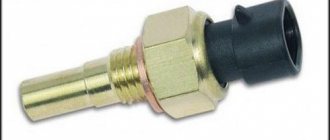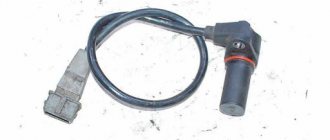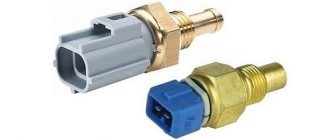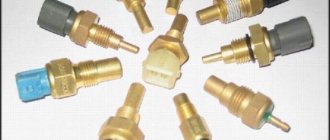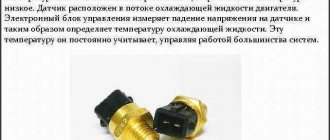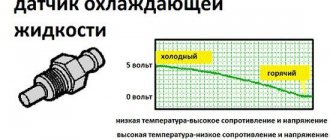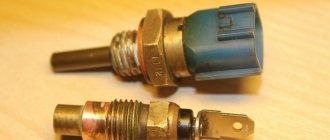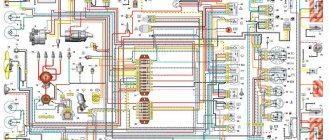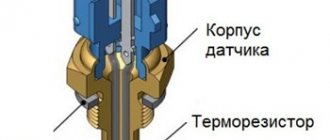Every car owner knows that the operation of systems is controlled by special sensors. They are located in different places of the mechanisms. If such elements fail, the likelihood of malfunctions in the operation of system elements increases. In this case, repairs will be expensive. To eliminate the possibility of such a problem, periodically check the system sensors.
Control devices are responsible for the operation of many components and mechanisms. They need to be able to control them correctly. How to check temperature, pressure, air and other types of sensors will be discussed in detail in the article.
Sensor operation
Before you familiarize yourself with the technology of how to check the idle speed sensor, oil pressure, temperature and other types of control devices, you need to consider the features of their operation.
The main devices of this type monitor the functioning of the motor and related systems. It is the engine that needs precise control of the operation of its elements and systems. Its failure entails the need for major repairs. To avoid large financial costs, it is recommended to check the functionality of the sensors.
Control devices are responsible for testing the heating level of the system and coolant. They provide measurement of the condition of various components during idling, in normal mode, etc. Every car owner should know how to check the temperature, air, oil pressure and other similar devices.
Incorrect operation of the DTOZH. Guidelines for the driver.
The simplicity of the device guarantees its long service life. But sometimes it fails. If the sensor is broken, it must be replaced. This is a consumable item and cannot be repaired. However, the vast majority of failures are related to electrical circuit integrity. Breaks, waste contacts, rust and dirt are the main triggers for opening the circuit. It is precisely these problems that every car enthusiast can identify and fix himself.
The device does not break down instantly; shortly before “death” it sends distress signals, which the driver must be able to recognize. Among them:
- The fan does not turn on. This, of course, is not the main symptom, however, the very first alarm bell;
- Increased gasoline consumption;
- Idle speed too high;
- Characteristic sounds of engine detonation;
- Difficulty starting;
- Increased heating of the motor, up to absolute overheating;
- Error message from the on-board computer.
Among the many reasons for device failure, we highlight the most important:
- Poor quality coolant. Leads to the coating of the surface of the sensitive element with crystalline sediment, and also destroys the surface of the sensor;
- Leakage and decrease in antifreeze level. The cause is a worn gasket. Depressurization of the housing;
- Poor quality, counterfeit device;
- Violation of the integrity of the electrical circuit. This is a whole complex of reasons - corrosion, uneven current supply (voltage surges), breaks, poor soldering of pins, incorrect connection of contacts, short circuits, loss of voltage, accumulated carbon deposits on the wires;
- Pollution.
temperature sensor
There are a number of recommendations on how to check sensors on a VAZ, Chevrolet, Mercedes and other brands of cars. One of the most important indicators is a device that measures the heating of the coolant. This device transmits the collected data on the state of antifreeze to the engine control unit. He, in turn, adjusts his work based on the data received. In this case, the correct fuel supply level and ignition angle are adjusted.
On many cars (including VAZ, Kalina, Priora, Granda, etc.), the temperature control sensor switches the system to the electric ventilation type of cooling. Its readings are often displayed on the dashboard. This allows the driver to monitor the condition of the engine and its antifreeze. Modern vehicle models are equipped with temperature control sensors that have a negative heating coefficient. This means that as heating increases, the resistance of a given element decreases.
How to connect components. Detailed recommendations
The wiring should be laid at the greatest distance from objects from which electrical noise emanates, that is, these can be high-voltage wires, coils, etc. Wires must not come into contact with movable parts of the vehicle structure. Such parts are pedals, steering rods and similar objects.
- Transceiver connection process
The transceiver module, on which the antenna is present, is connected using a cable to a five-pin connector. The cable itself is a component for a car alarm.
The LED plug must be inserted into a socket with two pins.
- How to activate the service button
The plug must be connected to a socket with two contacts.
The two types of sensors must be integrated into the central unit using cables with four wires, which are included in the sensor or car alarm kit. A synchronous supply is made to the auxiliary “body” sensor (potential) along with the appearance of a signal on a black and white wire, which is part of the alarm system. After you connect the additional sensor, you will need to program function four, table, according to the correct algorithm.
Operating principle of the temperature sensor
When considering how to check engine sensors, you need to study the basic principle of their operation. One of the most important things in the system is the antifreeze temperature control device. The control unit sends an electrical signal to this sensor. It has a voltage of 9 V. When this happens, the reader takes a resistance reading at the sensor contacts. The system sends this data back to the control unit. At the same time, she will be able to calculate, using a given logarithm, how the engine should operate under such circumstances.
If the temperature has increased, the resistance should decrease. In this case, the system, using its special mechanisms and electronic devices, regulates the level of fuel consumed during engine operation. This allows you to reduce the heating temperature at the right time. Antifreeze in this case will be able to properly cool the system. When the temperature drops significantly, the presented mechanism will help adjust the engine operation in the opposite direction.
No special mode
Is it possible to measure temperature with a multimeter that does not have a special mode for this? It turns out that this can really be done, but the device will need to be slightly upgraded.
You need to purchase an LM-35 microcircuit, with its help the temperature readings will be converted into voltage, and the device will be able to recognize the data, but will indicate them in Volts. For example, 0.30 Volts will need to be understood as 30 degrees Celsius.
The use of a microcircuit does not require complex intervention in the design of the device and allows you to use any multimeter to measure temperature.
In order for the chip to work, you will need:
- three wires that can be connected to the 10-ohm output of the device;
- a separate power source of at least 4 Volts, that is, 2 flat batteries.
If you need to measure not only positive, but also negative temperatures, you will also need to connect a reference voltage source.
The microcircuit itself is easy to connect. It has three connectors for positive and negative wires and an output sensor. This approach will allow you to transform any multimeter, making it more functional, while the design will be inexpensive.
How to remove the sensor?
When considering how to check the coolant sensor, you need to learn how to properly dismantle this element of the system. Drivers often confuse this element with the device that controls the fan. You don't need to look for it on the back of the fan. The temperature sensor is almost always installed in one of two possible locations. In the first case, an antifreeze heating control device can be installed near the thermostat. Moreover, it can be located directly in its body. In the second case, the sensor is installed in the cylinder head. It should be located in close proximity to one of the cooling system pipes.
To dismantle, you will need to drain the antifreeze from the radiator. Next, remove the air filter if the car is of the injection type. You can unscrew the sensor using a wrench. In foreign cars, dismantling can be more difficult. Often the sensor is located at the rear of the cylinder head. In this case, during dismantling you will have to disconnect several hoses.
Where is
To check the DTOZH, you need to know its location. Please note that the location of the sensor may vary depending on the make/model of the machine.
Most often, the thermistor is mounted between the cylinder head and the thermostat or on the coolant outlet pipe.
But on some cars it is installed on the radiator pipe.
Externally, the device looks like a small element with a thread, with which the DTOZH is screwed into a special hole. In this case, the regulating element itself is located in the antifreeze and controls its temperature.
In certain cars, for example, the BMW E39, there may be two DTOZH. One controls the heating of the antifreeze and is installed at the outlet of the engine, and the second is located behind the radiator. To remove you will need a 22 key.
This type of installation allows you to control the temperature in different areas and thereby take action faster.
Note that two sensors are installed on powerful / expensive cars, where the temperature parameter is of key importance.
In this case, the control unit must have appropriate programs. For more information, please refer to your vehicle's manual.
Functionally, the sensor is very reliable and breaks down in rare cases. Most often it shows false information. Sometimes other damage is possible, for example, chafing of wires or poor contact quality.
As for the features of the location of the DTOZH on different models, we will dwell on this issue below.
Checking the sensor operation
The method of how to check the temperature sensor is described in detail by the vehicle manufacturer. To carry out such work, you will need tools, a tester, a container of water, a stove, a thermometer with divisions up to 120 ºС, and a basin for antifreeze. First you need to turn off the radiator and drain the antifreeze from it. After this, the sensor is dismantled. The container with water must be placed on a gas or electric stove. The sensor must be lowered into the liquid. Its brass part should be completely immersed in water. The plastic should be on top.
Gazelle (engines ZMZ 406, 405, 409)
Installation location - on the power unit in the area of the thermostat or on the body of the latter.
To remove it, it is necessary to partially drain the coolant from the engine, disconnect the spring clamp of the harness block and discard the block from the sensor.
Next, using a key set to “19” you need to loosen the broach and unscrew the device.
When choosing a device, you need to focus on the engine and ECU.
406 engine and ECU Mikas 7.1, 5.4, SOATE, VS5.6
In such cases, a DTOZH is used, operating at a voltage of 5 to 12 Volts through a resistance of 9.1 kOhm.
Several types of devices are suitable for replacement: Kaluga 19.3828, Luzar LS 0306, Rikor 40.5226 or Autotrade 42.3828.
POPULAR WITH READERS: MPI engine - modifications, pros and cons
When checking, you will also need water with a boiler and variable temperature, as well as a multimeter.
To work, you need to assemble a circuit and apply 1 to 1.5 mA to it. In this case, it is necessary to measure not resistance, but voltage.
When checking, the following parameters must be present:
- -60 C - 2.13 V;
- -40 C - 2.33 V;
- -20 C - 2.53 V;
- 0 C - 2.73 V;
- +40 C - 3.13 V;
- +80 C - 3.53 V;
- 105 C - 3.83 V;
- 125 C - 3.98 V.
When the engine is running, the voltage will be 5 V.
Engine 405, 409, UMZ 4216E3, 4213 control unit Mikas 11 / 10.3, VS8, SOATE
DTOZH with catalog numbers 234.3828, 40.5215 or 421.3828 are used here.
Unlike the method discussed above, here it is necessary to measure resistance.
In this case, the dependence should be as follows:
- 128 C - 80.8 Ohm;
- 100 C - 177 Ohm;
- 80 C - 332 Ohm;
- 60 C - 667 Ohm;
- 40 C - 1459 Ohm;
- 20 C - 3520 Ohm;
- 0 C - 9420 Ohm;
- -20 C - 28680 Ohm;
- -40 C - 100707 Ohm.
In case of significant deviations from these parameters, the device must be replaced.
Idle speed sensor
Drivers may be interested in how to check a car's idle speed sensor. This device is also responsible for ensuring stable engine operation. It only controls this process at idle. This sensor controls the amount of air that is supplied to the motor in this operating mode.
In this case, it is no longer the antifreeze liquid that is measured. The idle air supply system has certain components. It has a valve in the form of a conical needle. This element prevents air from entering the system. The needle is driven by a small motor that runs on electricity. The damper is set in motion when the motor is turned on. The needle can open or close the gap through which air enters the engine. Moreover, the diameter of this hole is also adjustable due to the special configuration of the damper.
Review of manufacturers
There are many companies involved in the production of heated floors. The most popular brands are Devi, AEG, Thermo Industri AB. Each manufacturer's sensors have their own characteristics.
Devi devices
Temperature regulators of this brand work with any type of heating elements. They are divided into mechanical and electronic, with conventional or touch controls. In addition, the Devi line of regulators includes models controlled remotely via smartphones.
Advantages of devices of this brand:
- availability of models for outdoor installation;
- savings on the operation of heating appliances up to 30 percent;
- availability of control via the Internet.
The advantage is the variety of options to solve any problem.
AEG regulators
Thermal sensors of the German brand belong to the premium class. Excellent quality guarantees durability and trouble-free operation. But such devices also cost a lot.
The product range is wide: from simple basic devices to “smart” temperature sensors that fully control the operation of the heated floor and the microclimate in the room.
But even basic models have many advantages:
- maintain temperature indicators at the required level;
- controlled very simply - by manually turning the key on and off;
- Thanks to convenient controls, they are suitable for older people who are not familiar with programming.
An external timer can be connected to the device to control the temperature reduction mode.
Devices Thermo Industry AB
Such thermostats are installed exclusively indoors. Capable of controlling elements of a heating cable or thermomat. Models have been developed that are ideal for parquet or laminate flooring. Most devices are equipped with smart air temperature meters.
Electronic devices are capable of adjusting heating with an accuracy of 1°C.
They are used for anti-icing systems if it is possible to combine them with a thermostat in the house. Built-in intelligent heating sensors make it possible to reduce electricity consumption, and Swedish quality guarantees many years of operation.
Symptoms of a problem
Before you learn how to check the air sensor, you should consider under what circumstances you need to suspect a malfunction of this particular element of the system. If the control device fails, the car will stall when stopping at traffic lights. In this case, the driver will have to hold the gas pedal while waiting for the green light.
Unstable engine speed also indicates a malfunction of the idle speed sensor. This can be heard even without the use of special equipment. It also takes a long time to warm up the engine. Even in warm weather, starting a car becomes problematic. Even after warming up, you have to drive on “choke” for a long time. The driver may also notice that when the transmission lever is moved to neutral, the engine begins to operate unstably. At the same time, it may even stall. In this case, you will need to check the idle speed sensor.
DTOZH malfunctions and step-by-step elimination
DTOZH has a simple design, so it rarely fails. Breakdowns most often occur when the shelf life is exceeded, as well as in the event of an accident when the device is damaged due to a mechanical shock. The main malfunctions of the DTOZh are damage to the housing, failure of chips, oxidation of contacts and some others.
A faulty DTOZ can be determined by the symptoms, which can be divided into two groups. The first category includes typical symptoms that are similar for all types of failure (for example, they can appear both when the case breaks and when the contacts oxidize). The second group includes special symptoms that are characteristic only of one type of fault (for example, a jumping arrow when there is an insulation failure).
Typical symptoms:
- Activating the Check Engine light on the control panel. The lamp is activated by the car's electronic control unit if it detects any breakdown in the car. Unfortunately, most modern ECUs do not specify where and why the breakdown occurred, and the Check Engine error can occur for many other reasons - from engine tripping to transmission damage. To understand the specific cause of the breakdown, you need to buy an OBD2 adapter and connect it to the control panel. After this, you need to go to the device wirelessly and look at the specific error code.
- Increased vehicle fuel consumption . Due to a malfunction of the sensor, incorrect information about setting the steps of the fuel supply regulator will be supplied to the electronic control unit. This usually leads to increased injection of gasoline/diesel into the internal combustion chamber, which will lead to increased fuel losses while driving.
- Chaotic operation of the cooling fan. The electronic unit starts the rotation of the fan blades if the temperature of the antifreeze rises above certain limits (usually 95-100 degrees) and there is a risk of evaporation. Depending on the specific cause of the DTOZh malfunction, many scenarios are possible - complete shutdown of the fan, intermittent on/off, constant operation of the fan at any load level, rotation of the blades only when the emergency mode is activated.
- Unstable engine operation when driving at light loads. Due to a malfunction in cooling and coolant supply, the engine begins to operate unstably, and stalls most severely in the hot season.
- There may be strong vibration when driving , slight jolts, and spontaneous stopping at low speeds.
- Sudden engine stop while driving “hot”. This symptom occurs if the antifreeze has heated above a critical point and began to evaporate, and the sensor does not start the cooling fan. As a result, the engine begins to heat up above a certain limit, and many ECUs forcefully stop the engine in case of excessive heating to avoid cracking and explosion. Engine stopping occurs in two cases - during long driving or at high speed, as well as in a combination of both factors.
Hull damage
The DTOZH body is made of strong metal. However, with mechanical shocks or under the influence of chemically active substances, it can oxidize and crack, which can lead to damage to the device.
A characteristic symptom: a sharp fluctuation in the temperature sensor on the control panel when driving at high speed. You can also detect a breakdown during an external inspection. and It is problematic to restore a damaged case; you need to change the spare part.
- Remove coolant from the system. To do this, place the car on the platform, wait until the car is completely cooled, and place a container under the drain hole.
- Unscrew the cap of the expansion tank and radiator, open the stove damper, unscrew the locking bolt of the hole in the engine. Wait until all the coolant has left the system.
- Open the hood, remove the negative terminal of the battery to turn off the power to the car.
- Find the coolant meter on the car, pull out the external contact (chip), and carefully unscrew the device from the hole.
- Install a new meter , and then carry out all the steps in reverse order.
Carry out work wearing gloves . There may be remnants of old coolant on the end of the old unit.
Oxidation of thermal contact
The thermal contact can oxidize upon contact with liquids or simply from old age, as well as in the case of using low-quality coolers (they contain many free ions that will settle on the thermistor). The problem occurs more often in older cars. The disorder has no specific symptoms.
To diagnose, visually inspect the contacts. If the problem is oxidation, the thermistor should become covered with black spots. There is no way to fix the problem manually. A new meter needs to be installed.
Instructions for replacing it can be seen in the video:
Malfunction of electrical contacts
A spare part may stop working due to damage or oxidation of the electrical contacts, and most often such a breakdown occurs in older cars. This malfunction has a characteristic symptom - if the electrical contacts are damaged, the device does not always fail. Therefore, the meter can periodically transmit correct data on the heating of the engine cooler.
For diagnostics, it is recommended to use an ohmmeter or multimeter. If the device gives zero voltage/resistance readings or the readings change frequently, then it is most likely a faulty electrical connection. A breakdown can also be detected during an external inspection (traces of corrosion or melting will be visible). There is only one solution to the problem - completely replacing the sensor according to the instructions above.
Chip damage
A chip is a system of contacts that are connected from the electronic control unit of the machine to the DTOZH. The chip may fail if the contact head is damaged. Unfortunately, damage to the chip does not have characteristic symptoms, so it is possible to establish a breakdown only if you have ruled out other possible breakdowns (housing, insulation, DTOZh contacts).
You can establish a breakdown using a multimeter, which you need to “probe” the head of the chip. Restoration should be done like this:
- Disconnect the battery by removing the negative terminal. Find the chip in the car and carefully remove it from the temperature sensor and vehicle ECU.
- Inspect the device - if the head is really damaged, then you need to buy a new chip and install it on the car.
Violation of wire insulation
Another reason for the failure of the DTOZh is damage to the wire leading from the chip to the electronic unit. The breakdown has a characteristic symptom - it usually makes itself felt when driving at high speeds, when the level of vibration of the car increases. For diagnostics, it is recommended to use a multimeter to “feel” the wire. There are three ways to restore your car's functionality:
- Using a multimeter, you can find the specific area where the wire damage occurred. You can restore the insulation using electrical tape.
- If a specific section cannot be found or the wire is severely damaged, it is recommended to cut off the old wire and solder a new one.
- Most motorists do not look for a specific area where the insulation has broken - instead, they buy a new chip with a whole wire and connect it to the system.
Checking the idle speed sensor
If the listed malfunctions appear, you need to consider how to check the idle speed sensor. It is located on the throttle valve. Her cable is attached next to it. Above the idle speed sensor is a throttle position control device. You need to turn off the ignition and dismantle the presented device. The sensor can be attached using adhesive or bolts. In the first case, you will need to dismantle the entire throttle assembly. The bolted connection will allow you to disconnect only the sensor.
Next, you need to connect the on-board network wires to the sensor. You need to place your finger on the conical needle. Next, the ignition is turned on. If after this you feel slight jolts of the needle, then the sensor is working. Otherwise, this structural element will be motionless. The sensor will need to be replaced.
Direct installation
As noted above, the VAZ ambient temperature sensor is not difficult to install. Especially if all connectors are provided by the manufacturer. The next step is purchasing a sensor. There is nothing complicated, we go to the car store and buy the thing we need. The most optimal location for the sensor is near the radiator. The mass can be thrown over the welded pin. The wires need to be pulled into the interior. How this will be done is up to you. The most convenient and shortest way is through the clutch plug. Of course, you can’t do without disassembling the instrument panel. We dismantle it and look for the 25th contact. It is precisely intended for the ambient temperature controller. Readings on the on-board computer usually appear automatically. If this does not happen, reset the battery terminal for 10-15 minutes. After this everything should work. The VAZ ambient temperature sensor costs a penny. Its installation does not take much time.
Checking the oil pressure sensor
A malfunction of the oil pressure sensor can lead to engine malfunction. Therefore, it must be periodically checked for functionality. How to check the oil pressure sensor? There is a certain technology for this. It involves dismantling the control device. Next you need to connect the multimeter contacts to the sensor. It shows zero resistance. Next, use the pump to pump the oil. The chain must break. In this case, the device shows infinity. This indicates that the sensor is fully operational. Knowing how to check sensors, you can ensure normal operation of the motor and all systems for a long time.
Electronic devices for measuring the temperature of antifreeze circulating through the engine water jacket have been used on cars since Soviet times. The breakdown of this element has always been considered a serious problem, since without temperature control in the cooling system, the engine can easily overheat and damage the piston group. Therefore, it is important for a novice motorist to know how to identify the symptoms of a malfunction of a temperature sensor in time, and changing it will not be difficult.
Operating principle and functions of the device
The design and operating principle of the temperature meter have changed little since its first use on a car. Due to modern materials used in the manufacture of the sensor, it has decreased in size, and the accuracy of the readings has increased. The device is a thermal variable resistor enclosed inside a metal case with a threaded tip . When heated, the thermoelement reduces the resistance of the electrical circuit, which allows the electronic control unit (otherwise known as the controller, ECU) to determine the temperature of the coolant.
The following functions depend on the operation of the temperature sensor:
- Traditionally, the coolant temperature indicator operates from meter signals.
- Timely activation of forced engine cooling fans when the antifreeze reaches the set temperature threshold (about 100 °C).
- Enriching the air-fuel mixture and increasing idle speed on a cold engine.
- While driving, the controller collects readings from all sensors and, on this basis, forms the ratio of fuel and air in the mixture. The temperature meter is also involved in this process.
The design of a modern car may provide for the installation of several heating meters responsible for certain functions. Their location varies:
- on the upper pipe leading from the cylinder block to the radiator;
- in the thermostat housing;
- in the cylinder head;
- directly into the radiator.
Checking the removed DTOZH
For a more accurate check, it is recommended to remove the device from the vehicle. To do this, you need to let the engine cool, and then drain the coolant from the system.
To remove it, you only need a key “19” (20, 21, 22), with which you can unscrew the sensor and remove it together with the ring.
At the same stage, it is worth assessing the condition of the device itself, its threads, cleaning and lubricating it.
The same operations can be done with respect to the sensor itself. After dismantling is completed, you can proceed directly to work.
Checking with a thermometer
After dismantling, you can check with a thermometer. This option provides the most accurate information, so it is recommended for most cases.
The algorithm of actions is as follows:
- Prepare a vessel and pour water into it.
- Use a boiler to heat water.
- Prepare your multimeter for measurements.
- Immerse the sensor element in the liquid.
- Provide the ability to connect a multimeter to the contacts.
- Place a thermometer in the water to monitor the temperature. It is better to use the electronic version, which provides greater accuracy.
- Heat the water and take measurements for different temperatures, for example, from +5 degrees Celsius and above in steps of “5”.
- Fill out the table containing the resistance parameters in relation to the set temperature.
- Check with the information provided in the vehicle manual.
Of course, inaccuracies may occur during the measurement process. The error depends on several factors: operating conditions and the characteristics of a particular DTOZH. In particular, even in devices of the same model, the resistance parameter may differ.
Without thermometer
If desired, checks can be made without using a water temperature meter.
In this method, you can act according to the principle discussed above, but with minor restrictions.
The general algorithm is:
- Boil the water.
- Install the DTOZh sensitive element into it.
- Measure the resistance at the terminals.
At a temperature of about 100 degrees Celsius, the resistance should be about 177 ohms. But here you need to take into account possible errors.
In particular, at the time of measurements, the temperature may change downward.
The disadvantage of the method is that the test is performed only at one temperature point.
What symptoms indicate problems with the sensor?
During long-term operation of the car, obvious and indirect signs may be observed indicating problems with the temperature sensor or its electrical circuit. The first ones directly indicate the need to check the functionality of the device:
- The engine heating indicator on the dashboard stopped working;
- the cooling fan stopped turning on, although the engine water jacket had already warmed up to 100 °C;
- antifreeze leakage from under the part body;
- The fan starts at random, including when the engine is cold.
If your car exhibits the listed signs of a malfunction of the coolant temperature sensor, then feel free to proceed to diagnosing it and fixing the problem, which will be discussed below. Indirect symptoms may indicate a breakdown of the meter or other elements of the cooling system or power unit. Here are the most common ones:
- Cold starting of the engine is difficult. The car starts, but immediately stalls, you need to make several repeated attempts. The cause may be a thermocouple, throttle position sensor, insufficient compression or ignition problems.
- Unstable operation at idle. In addition to the temperature meter, it is affected by the serviceability of the spark plugs, mass flow sensor, injectors and many other factors.
- The temperature is within normal limits, but the coolant begins to boil. If the thermostat fails or the level of antifreeze in the jacket decreases, then the readings of the device may differ from the real state of affairs.
The serviceability of an electronic temperature meter can be checked at home. If indirect symptoms of a malfunction are observed, the test will help to identify them or exclude them from a number of parts that are “under suspicion.” If you successfully check the problem, you will have to look elsewhere or contact the nearest auto repair shop.
Purpose of the device
DTOZH should not be confused with an antifreeze level controller. If the first is intended to detect the temperature of the power unit, then the second is used to control the volume of consumables - refrigerant. Based on the DTOZH readings, the control unit detects temperature changes and transmits data to the on-board computer about the state in which the engine is operating. Using the controller, engine warm-up, overheating, and the optimal temperature of the operating internal combustion engine are determined. Pulses transmitted to the control module determine the functionality of the internal combustion engine control system as a whole.
We recommend: Which is better dependent and independent suspension, what are the differences
The engine temperature determines the following nuances:
- fuel consumption per 100 km;
- volume and quality of gases;
- ignition of the air-fuel mixture;
- optimal operation of the gearbox.
All these factors are controlled by a control device, which, based on the information received, determines the optimal operating mode of the engine. Therefore, the performance of the temperature sensor is important for the vehicle. If the device is faulty and sends incorrect pulses to the control module, this can lead to problems.
How does DTOZh affect the operation of the internal combustion engine?
Based on the parameters supplied to the control device, the module performs the following functions:
- Enrichment of the air-fuel mixture or its depletion. If the controller detects that the temperature is too low, it will begin to increase the duration of the signal sent to the injectors, which helps to enrich the fuel mixture. In accordance with the normalization of the temperature regime, the fuel is gradually depleted, which prevents possible excessive consumption of gasoline and reduces the volume of exhaust gases. If the sensor breaks down, it can regularly lower the temperature in the engine, which will lead to fuel contamination and increased consumption.
- The control unit sets the ignition. It can be early or late. If the temperature increases, the control module adjusts the ignition timing to reduce exhaust toxicity.
- Thanks to DTOZH, proper recirculation of gases is performed during warming up. The recirculation valve closes tightly when the power unit warms up. If the car’s engine is still cold, then recirculation will cause fluctuations in idle speed and random engine stops.
- With the help of DTOZH, the control unit purges the filtration system, which traps fuel vapors. To achieve better machine controllability, the carbon filter element is not purged until the engine is completely warmed up.
- Locking of the gearbox torque converter when the internal combustion engine warms up. The control module should not limit the operation of the device until the machine warms up.
- The ECU controls the operation of the unit's cooling fan. Based on the temperature controller readings, the module activates and deactivates the ventilation device to correctly select the temperature of the unit. If the DTOZ gives incorrect impulses, there is a possibility of the motor overheating.
Performance test
To check the thermal sensor, it will have to be removed from the car. To do this, follow these steps:
- Allow the engine to cool to 40-50 °C to avoid burning your hands during operation. Partially or completely drain the antifreeze from the cooling system.
- Disconnect the battery from the on-board power supply by removing the negative cable.
- Disconnect the block with wires from the thermoelement.
- Unscrew the part using a wrench of the appropriate size.
If the device is installed at the top point of the system, then it is not necessary to empty it entirely; it is enough to drain a third of the liquid into the container. All antifreeze must be drained when the thermocouple is located at the bottom of the radiator.
To carry out the tests you will need:
- a multimeter or other device capable of measuring circuit resistance;
- a small container for water (you can use a regular glass);
- thermometer with a scale up to 100 °C.
A thermometer is essential if you want to make accurate resistance measurements by referring to the reference chart for your vehicle. When there is no table, the serviceability of the part is checked without a thermometer according to its operating principle: the hotter the water in the glass, the lower the resistance at the contacts should be.
Before checking the coolant temperature sensor under heating, test its contacts with an ohmmeter. It may happen that the device has burnt out or has a short circuit. Then further manipulations become meaningless and the element must be changed, since it cannot be repaired.
If the multimeter shows a certain resistance, then immerse the thermocouple in a glass of cold water and record the readings. Then add hot water and watch the resistance change, it should decrease. If there are no changes, purchase and install a new temperature sensor.
If the tests were successful and the device changes resistance when heating the water, then it is worth checking the connecting wires and cleaning the contacts. Little things like this often cause major problems.
How to check the temperature sensor ?
Modern cars are equipped with a huge number of different sensors, each of which does its own task of collecting information. The acquired data is sent to the control, which receives the signals, processes them and issues subsequent commands to the injectors, engine cooling system components, etc.
Purpose
So, one of the more common and necessary devices is a cooling water temperature sensor (abbreviated as DTOZH). Its task is solely to inform the control unit in a timely manner about an excessive increase in temperature. Then the “brain” of the car, based on the software “poured” into it, gives one or another command (for example, to turn on an additional cooling radiator fan).
Instructions for removing, replacing and connecting DTOZH
Dismantling the TOZh controller
How to change the coolant temperature sensor with your own hands? Before replacing the controller, you need to know exactly where it is located in your car; you can use the service book to clarify.
The replacement process looks like this:
- Open the hood of the car and unscrew the filler cap of the antifreeze reservoir.
- Then you need to place a container under the refrigerant drain hole, and unscrew the hole cover.
- Disconnect the wire that powers the controller.
- The controller itself, depending on the design features of the car, can be fixed with a latch, a clamp, or screwed in with a thread. Dismantle the device.
- Next, the coolant temperature sensor is installed. Before installation, the replaced device can be treated with a sealant, in particular, we are talking about contacting surfaces.
- Refill with antifreeze.
Price issue
The cost of the device is determined by the model of the car in which it will be used, as well as by the manufacturer. JP GROUP regulators cost about 200 rubles, from the manufacturer BERU - around 350 rubles, from the manufacturer Hella - approximately 700 rubles. Prices are average, excluding car model.

